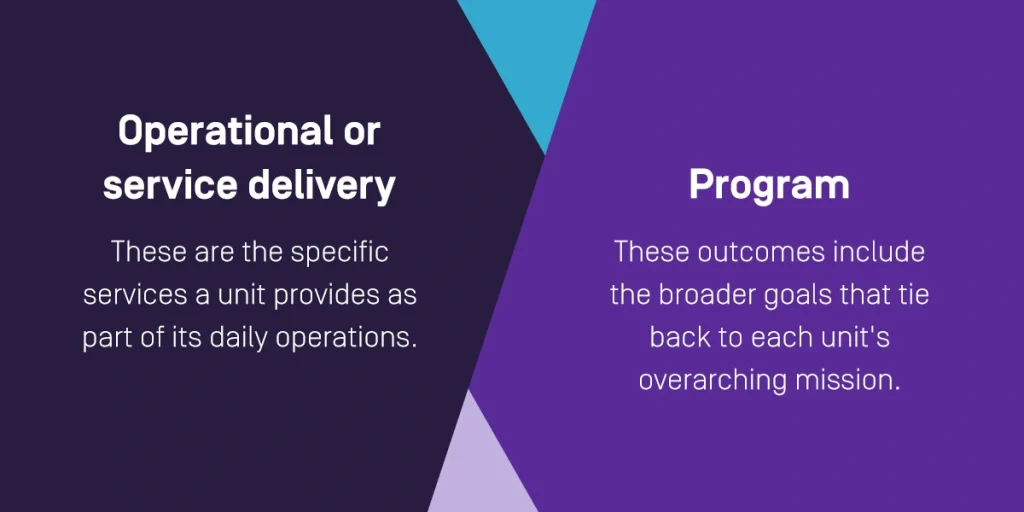




Is your institution achieving its mission? Are you missing the mark? Without a clear goal or sufficient data to evaluate your efforts, it’s hard to tell. Regularly assessing outcomes reveals how close you are to achieving key institutional goals such as increasing student success rates, boosting alumni engagement, and improving your facilities.
Every unit within your institution should create a list of outcomes that tie back to your overarching mission statement, including non-academic units.
Academic units are directly tied to student learning — the specific colleges within a university, the departments within each school, or any other entity that offers courses.
Non-academic units, on the other hand, are a little harder to pin down. It’s a broad category that includes any unit that indirectly encourages or facilitates academic success. While academics tend to take the spotlight, your non-academic units are what make up the foundation of your institution — without them, your institution can’t function.
Some of the non-academic units at your institution might include:
These units power institutional success by improving student well-being, enhancing internal processes, increasing enrollment rates, and more. Investing in these services is essential for facilitating continuous improvement — but first, you need to understand what outcomes to track and why.
Non-academic outcomes are similar to key performance indicators (KPIs) in that they help you measure the most important work being done at your institution. Tracking these outcomes helps non-academic units prioritize their services and improve their processes — and by keeping a close eye on progress over time, you can catch minor issues before they grow into major obstacles.
Some other benefits of setting and assessing clearly defined outcomes include:
Defining and assessing outcomes is also essential for achieving and maintaining institutional accreditation. By providing tangible proof of how your non-academic units contribute to student learning, you can streamline the accreditation process and improve your chances of success.

Success outcomes measure performance relative to goals, outline how each unit helps the institution achieve its mission, and monitor key metrics. In some cases, non-academic units that interact with students could link their work to learning outcomes to demonstrate learning that takes place outside the classroom.
There are two types of outcomes you can assess for non-academic units:
Here’s how those outcomes can translate into specific outcomes that can make a major impact on your institution:
Regular assessment and reflection can help leaders of non-academic units identify ways to continuously improve these outcomes. It can also guide them in determining whether a specific outcome is worth measuring. If not, they can use the data they collected during assessment to choose another outcome.
The simplest way to start setting effective non-academic outcomes is to involve non-academic units from the start. Help them see where they fit into your institution’s mission so they can identify which outcomes to develop.
Additionally, you’ll need to ensure each outcome aligns with your institutional mission and vision. It’s a common misconception that non-academic units are unnecessary — but setting outcomes that clearly support your mission can help you eliminate that notion.
Take Union University‘s dedication to a culture of continuous improvement, for example. As part of its initiative to improve outcomes across the institution, the university equally emphasized academic and non-academic excellence in student success.
As a result of this commitment, Union’s Office of Institutional Advancement created an alumni Facebook page that gained 2,900 followers and helped bring in 275 more donations year over year.
So what data can you use to assess these outcomes? Like with academic outcomes, a mix of direct and indirect assessment measures will be important for evaluating unit performance. Unlike academic outcomes, though, your direct measures will come from sources other than student work.
Some examples of assessment measures you might use include:
Adopting a robust outcomes assessment solution can help you streamline this process by applying predefined rubrics to your assessments. Powerful reporting and tracking capabilities allow you to monitor progress so you can identify potential issues early, and interactive visualizations make your insights accessible to all stakeholders.
Once you know what outcomes you want to improve, you need a strong data infrastructure to help you plan your next moves. That’s why we at Watermark have made it our mission to provide higher education institutions with powerful analytics tools that drive continuous improvement.
Watermark Planning & Self-Study is our solution for gathering, analyzing, and understanding assessment data. Shared customizable templates support collaboration by enabling you to assign contributors to specific narratives, and deep integrations with other Watermark solutions enable you to pull the data you need without unnecessary friction.
Watermark Outcomes Assessment Projects helps you evaluate specific academic and non-academic outcomes so you can pinpoint key areas for improvement. Interactive reports allow you to drill in for more granular insights. And the solution’s reusable rubric and outcome libraries let you track progress by collecting data over time.
See how partnering with us can help you improve outcomes across your entire institution. For help in writing non-academic outcomes that will make an impact on your campus, check out our webinar series Assessment Foundations: Developing Quality Outcomes & Objectives.
To learn more about any of our assessment and accreditation prep solutions, we invite you to request a personalized demo.






























































































































































































































































































































































































